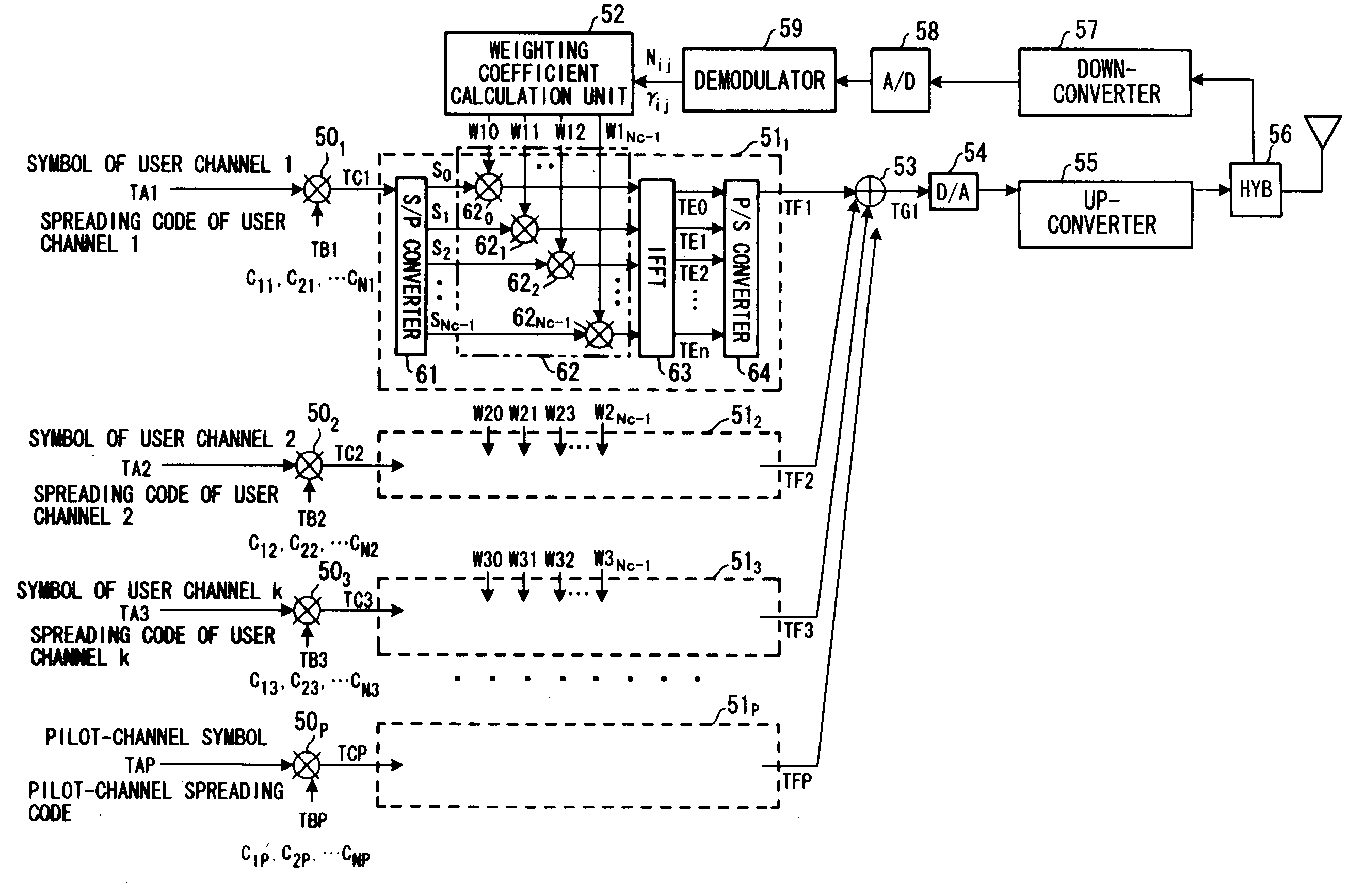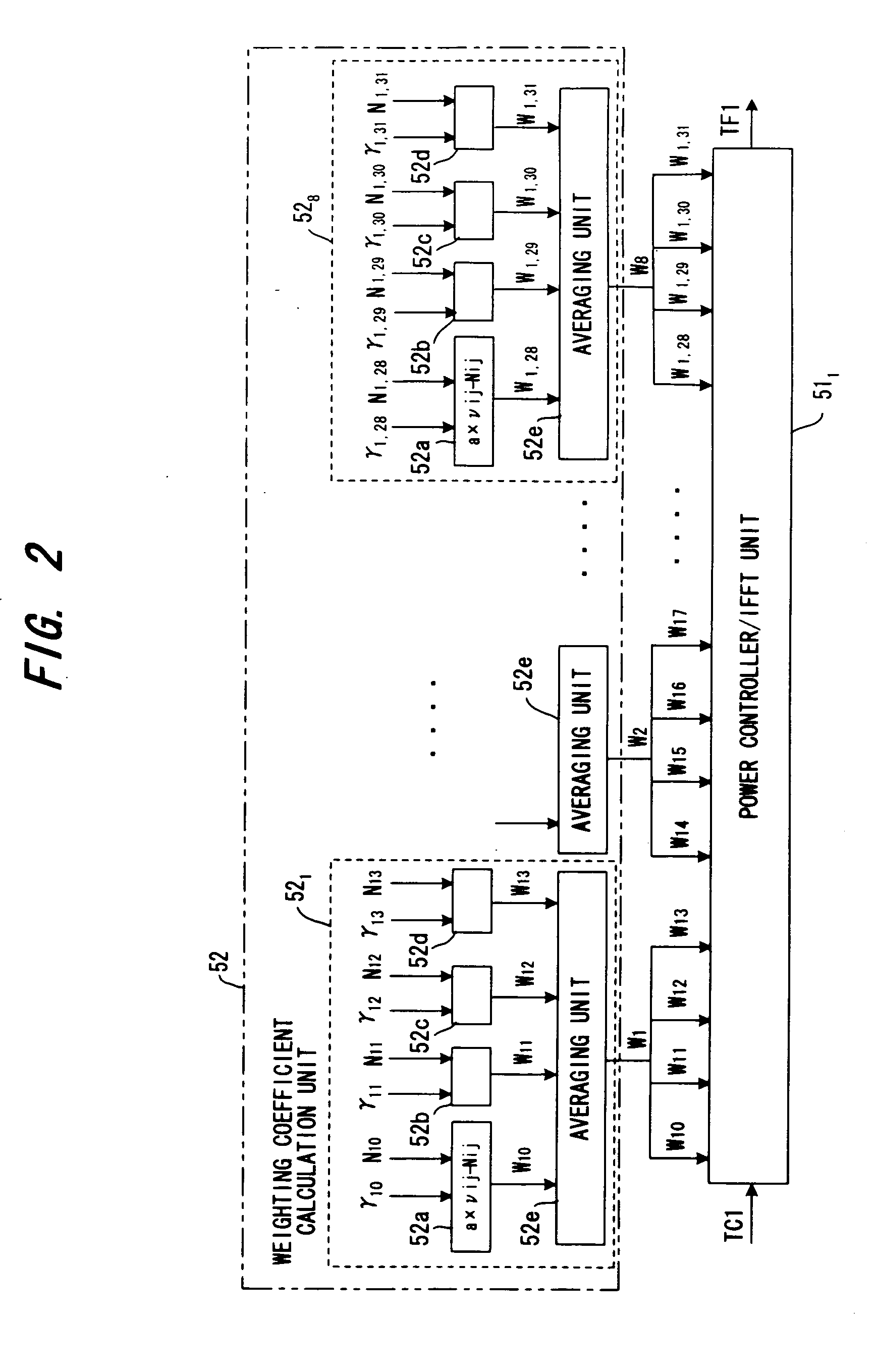Transmission power control method and transmission power control apparatus in OFDM-CDMA
a technology of transmission power control and transmission power, which is applied in the direction of power management, digital transmission, electrical equipment, etc., can solve the problems of reducing the orthogonality of channelization codes, affecting communication quality, and affecting communication quality, so as to prevent the degradation of communication quality
- Summary
- Abstract
- Description
- Claims
- Application Information
AI Technical Summary
Benefits of technology
Problems solved by technology
Method used
Image
Examples
first embodiment
[0065] (A) First Embodiment
[0066] Structure of Base Station
[0067]FIG. 1 is a diagram illustrating the structure of a base station in an OFDM-CDMA communication system according to a first embodiment. Transmit data of each user channel and pilot channel has been converted to a complex baseband signal (symbol) comprising an in-phase component and a quadrature-phase component.
[0068] A spreader 501 for the first user (first channel) multiplies each symbol TA1 of the first user by a channelization code TB1 (C11, C21, . . . , CN1) of the first user and outputs encoded data TC1. The channelization code TB1 has a chip rate that is SF times the symbol rate, where SF is the spreading factor and SF=N holds.
[0069] An S / P converter 61 of a power controller / IFFT unit 511 subjects M symbol's worth of N×M chip sequences to an S / P conversion. For example, if M=8, N=4 holds, the S / P converter converts 32 (=8×4) chips to parallel data S0 to SNc-1 (Nc=N×M) and outputs the parallel data. That is, the...
second embodiment
[0109] (B) Second Embodiment
[0110] In the first embodiment, weighting coefficients W1 to WM of the subcarrier blocks are calculated by the base station. In a second embodiment, the weighting coefficients W1 to WM are calculated on the side of the mobile station and are sent to the side of the base station so that transmission power control is performed for every subcarrier block.
[0111]FIG. 8 is a diagram showing the structure of a base station according to the second embodiment. Components identical with those of the first embodiment are designated by like reference characters. This differs from the first embodiment in that a weighting coefficient distribution unit 91 is provided instead of the weighting coefficient calculation unit 52. The weighting coefficient distribution unit 91 decides the weighting coefficients W1j (j=0 to Nc-1) of each subcarrier in accordance with Equation (1) using weighting coefficients W1 to WM that have been sent from the receiving side and inputs these...
third embodiment
[0113] (C) Third Embodiment
[0114] In the first embodiment, weighting coefficients W1 to WM of the subcarrier blocks are calculated by the base station. In a third embodiment, the weighting coefficients W1 to WM are calculated on the side of the mobile station, the calculated weighting coefficients W1 to WM are compared with present weighting coefficients W1 to WM, a increase / decrease in the weighting coefficients is decided and an UP / DN command is sent to the side of the base station so that transmission power control is performed for every subcarrier block.
[0115]FIG. 10 is a diagram showing the structure of a base station according to the third embodiment. Components identical with those of the first embodiment are designated by like reference characters. This differs from the first embodiment in that a weighting coefficient increase / decrease unit 100 is provided instead of the weighting coefficient calculation unit 52. Since the weighting coefficient UP / DN command is received fro...
PUM
 Login to View More
Login to View More Abstract
Description
Claims
Application Information
 Login to View More
Login to View More - R&D
- Intellectual Property
- Life Sciences
- Materials
- Tech Scout
- Unparalleled Data Quality
- Higher Quality Content
- 60% Fewer Hallucinations
Browse by: Latest US Patents, China's latest patents, Technical Efficacy Thesaurus, Application Domain, Technology Topic, Popular Technical Reports.
© 2025 PatSnap. All rights reserved.Legal|Privacy policy|Modern Slavery Act Transparency Statement|Sitemap|About US| Contact US: help@patsnap.com



